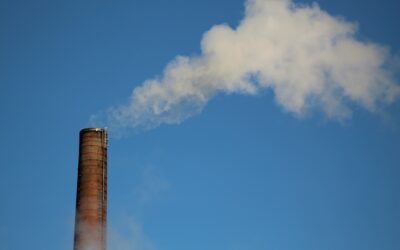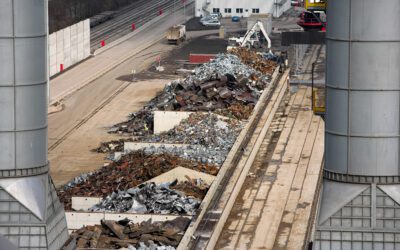Update of the EU ETS free allocation rules: Polluting for free during a climate crisis
In this joint op-ed, first featured in Carbon Pulse, Sandbag policy officer Aymeric Amand and Carbon Market Watch policy expert Lidia Tamellini examine the revision of the Free Allocation Regulation.
The EU Emissions Trading System (ETS) is one of the core EU instruments that will drive the decarbonisation of European industry and help achieve the transition to a net-zero economy by 2050 at the latest. It also embodies the “polluter-pays principle”, according to which “the polluters pay for measures to prevent, control and remedy pollution and for the cost to society of pollution”.
A large part of heavy industry carbon emissions is exempted from ETS obligations. The allocation system of free emissions allowances was designed to shield European heavy industries from the purported risk of “carbon leakage”, the alleged risk that industries will relocate their production outside of the EU to countries or regions with more lenient carbon emission policies.
Whilst free allowances have helped European industries face growing international competition, they have also allowed them to keep polluting at will. This is because allowances were only distributed, within each sector, to the most polluting processes, for example blast furnaces rather than units using recycled steel. Between 2013-2021 large polluting industries received a total of €98.5 billion in free allowances – i.e. more than what EU Member States collected from ETS revenues during the same period (€88.5 billion).
Delaying the transition to net-zero
Despite auctioning being the “default method of allocating allowances,” free allowances cover more than 95% of all industrial emissions in the EU. The current free allocation system does not create incentives to decarbonise and, as a result, industry emissions showed little decline over the last decade compared to the power sector.
Free allocation is scheduled to decline. Yet the sluggish pace of annual reductions (between 0.2% and 1.6% from 2021 to 2025, and between 0.3% and 2.5% from 2026 to 2030) is not compatible with the EU’s long-term climate goals. This lack of progress also means that EU Member States are missing billions of euros of ETS revenues that could otherwise be spent on social or climate-related policies and/or cleantech investments. Following the reform of the ETS adopted in May 2023, the European Commission was entrusted to update the Free Allocation Regulation (FAR). However, the internal process was delayed by changes in the Commission’s administration as well as by intense lobbying efforts. The much-anticipated draft legal act for the revision of the FAR was finally published on 5 December 2023.
Why the proposed revision fails to deliver social and environmental change
The new draft FAR reflects many of the demands of a handful of well-represented stakeholders, with incumbent emission-intensive industries already racking up several wins in their struggle to maintain a high level of free allocation for themselves. Regrettably, during the FAR revision process, the Commission not only failed to significantly reform several products’ benchmarks, but was also reluctant to fully implement the “one product =
one benchmark” principle. The claims of emission-intensive industrial sectors’ representatives were received and implemented throughout the proposal, allowing them to obtain less stringent definitions, to secure constant (or even higher) levels of free allocation and the exclusion of their carbon-free competitors from the scheme.
→ Cement benchmarks
- Cement benchmarks are still expressed in tonnes of (white and grey) clinker. However, the two benchmarks now also cover “alternative hydraulic binders”. This addition will allow some calcined clay to benefit from free allowances but only constitutes a very small improvement: most clinker alternatives and supplementary cementitious materials (SCMs) do not fall within the scope of the revision of the EU ETS (which, for instance, only covers cement production that involves rotary kilns) and will continue to be penalised by the free allowances distributed to clinker manufacturers. In other words, technological innovations that effectively lower the most polluting component of cement manufacturing will not be supported in this revision.
→ Steel benchmarks
- The steel sector is responsible for no less than a quarter of all the emissions covered by the EU ETS. Applying the “one product, one benchmark” principle to steelmaking could have dramatically helped to decarbonise the sector. However, here too, the Commission chose to continue allocating free allowances under different benchmarks.
- Most of the emissions associated with steelmaking result from the smelting process, which still benefits from its own dedicated benchmark despite being an intermediate manufacturing process. In the Commission’s draft, the “hot metal” benchmark now also covers direct-reduced iron (DRI) – which goes in the right direction. But crucially, by providing free allowances to specific intermediate manufacturing processes that all involve the transformation of virgin iron ore, the proposed revision of steel benchmarks will further penalise the circular reuse of scrap despite its huge potential to decarbonise the sector.
→ Amount of free allocation and Historical Activity Level (HAL)
The proposed reform does not provide for any reduction of free allocation, which will maintain a high level of adverse incentives. The calculation method for the Historical Activity Level (HAL) has always been based on the “average” level of annual production. In a (not so) surprising turn of events, the Commission is proposing to calculate it using a “median” level that would exclude the impact of years of lower production linked to the pandemic and the energy price crunch. Maintaining the use of the “average” level would not only be consistent from a regulatory standpoint, but would also adjust free allocation to real activity levels. Using the median amounts to applying a random statistical parameter to cater to vested industry interests. It’s important to highlight that heavy industries already cashed in an excess free allocation for 104.5% of their emissions in 2020.
→ Process emission value
The end goal of this value is to encourage the decarbonisation of heavily polluting production processes by comparatively reducing the amount of FA allocated for emissions not covered by the product benchmark. Despite earlier proposals by the Commission to lower the value to 0.79, the value set at 0,91 (almost as high as the current value, 0.97, which has been in place unchanged since 2013) and enforcing an unnecessarily late timeline (the new value will be enforced only starting in 2028) makes the revision of this parameter largely inconsequential and ineffective.
Crucial revision
The public consultation period for the FAR will run until 2 January 2024, followed by a two- month scrutiny period by the European Parliament and the Council during which both have the opportunity to reject the act. Unfortunately, the publication date and the short 4-week feedback period somewhat contribute to making this revision hidden to the general public. Those at COP28 were facing other priorities, and the holiday season has now begun, meaning the public consultation may not yield many responses. The revision of the FAR is nevertheless crucial, and policymakers should judge if polluting for free in times of a climate crisis is still tenable.
Photo by Christopher Burns on Unsplash
Read More:
2nd ETS trilogue: EU institutions agreed on almost nothing, except on perpetuating free allocation for the steel giants
The second ETS trilogue took place last week on October 11th. Tabled proposals on benchmarks regarding the steel…
European Scrap Steel Floats Away Under Carbon Market Incentives
Starting from scrap: transition to low-carbon steel can go faster with increased use of second-hand metal
New research by Sandbag indicates that a better use of end of life steel objects would help to speed up the reduction of emissions from the sector in Europe…



